Overview
It would be impossible to detail every type of insect flying, hopping, or crawling on Aereth. There are spiders, scorpions, flies, mosquitoes, butterflies...all the normal types of insects. For now, we are only going to document some of the unique types of arachnids.
Spiders are found all over the world, presumably except the poles (as on Earth). Spiders are highly adaptable creatures, so the various species are widespread. All arachnids have eight legs, although the front pair of legs in some species has converted to a sensory function, while in other species, different appendages can grow large enough to take on the appearance of extra pairs of legs.
Almost all extant arachnids are terrestrial. However, some inhabit freshwater environments and, except the pelagic zone, marine environments as well. They comprise over 100,000 named species, including spiders, scorpions, harvestmen, ticks, mites, and solifuges.
Arachnids are further distinguished from insects by the fact they do not have antennae or wings. Their body is organized into two tagmata, called the prosoma, or cephalothorax, and the opisthosoma, or abdomen. The cephalothorax is derived from the fusion of the cephalon (head) and the thorax and is usually covered by a single, unsegmented carapace. The abdomen is segmented in the more primitive forms, but varying degrees of fusion between the segments occur in many groups. It is typically divided into a preabdomen and postabdomen, although this is only clearly visible in scorpions, and in some orders, such as the Acari, the abdominal sections are completely fused.
Like all arthropods, arachnids have an exoskeleton, and they also have an internal structure of cartilage-like tissue, called the endosternite, to which certain muscle groups are attached.
Birdeaters
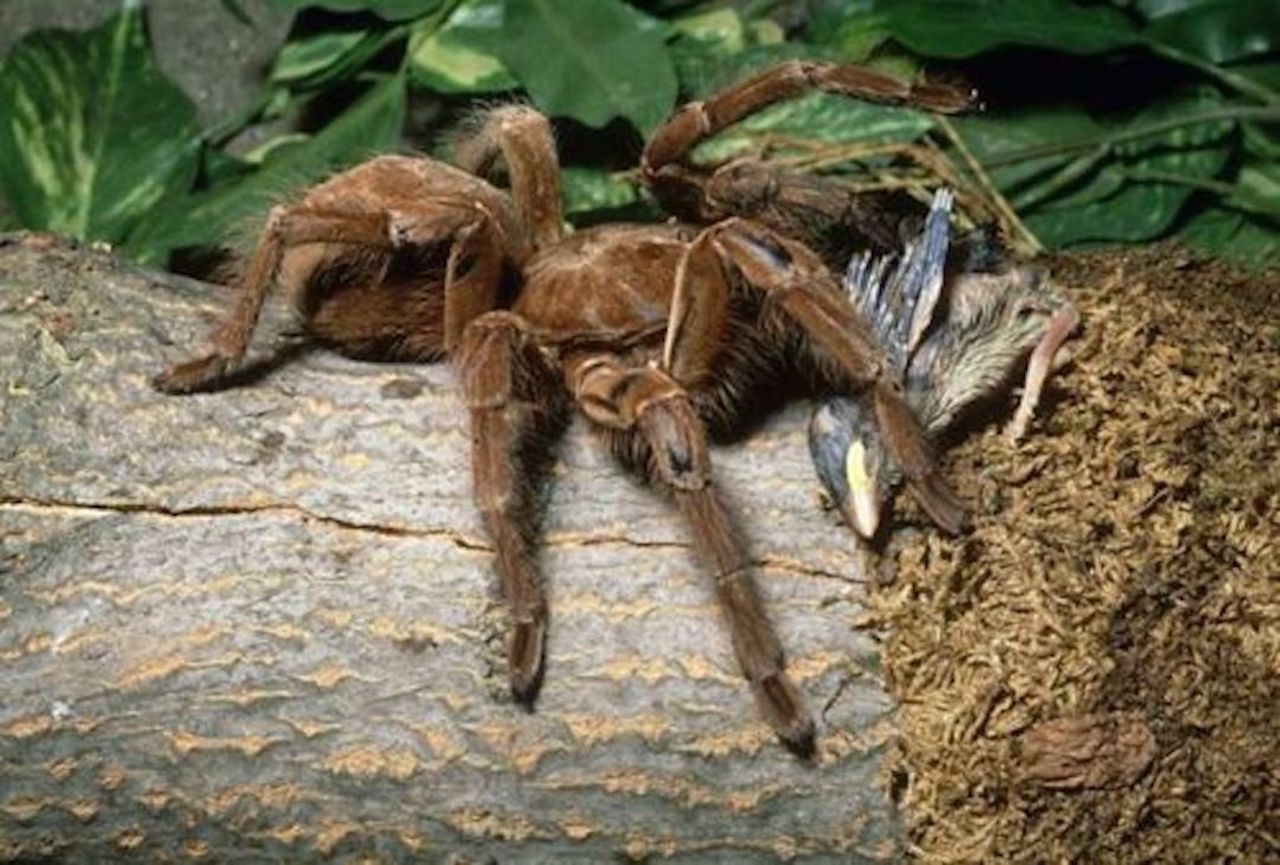
Aereth Birdeater
These spiders can have a leg span of up to 11 inches and can weigh over 6.0 ounces. Birdeaters are one of the few tarantula species that lack tibial spurs, located on the first pair of legs of most adult males.
In response to threats, birdeaters stridulate by rubbing setae on their pedipalps and legs. Also, when threatened, they rub their abdomen with their hind legs and release hairs that are a severe irritant to the skin and mucous membranes. These urticating hairs can be harmful to humans, and the species is considered by some to have the most harmful tarantula urticating hair of all
Like all tarantulas, the birdeaters have fangs large enough to break the skin of a human (0.75–1.50 in). They carry venom in their fangs and have been known to bite when threatened, but the venom is relatively harmless, and its effects are comparable to those of a wasp's sting. Tarantulas generally bite humans only in self-defense, and these bites do not always result in envenomation (known as a "dry bite"). There are tarantulas in the far eastern lands that have medically significant venom and do not have the urticating hair.
Despite its name and size, it is rare for the giant birdeater spider to actually prey on birds; in the wild, its diet consists primarily of earthworms. However, because of its size and opportunistic predatory behavior, it is not uncommon for this species to kill and consume a variety of insects and small terrestrial vertebrates. In the wild, the tarantula has been observed feeding on rodents, frogs and toads, lizards, and snakes
The giant spider is at home in the deep forests of Aereth although there are several large tarantulas inhabit the plains and deserts as well.
Tramp Spider
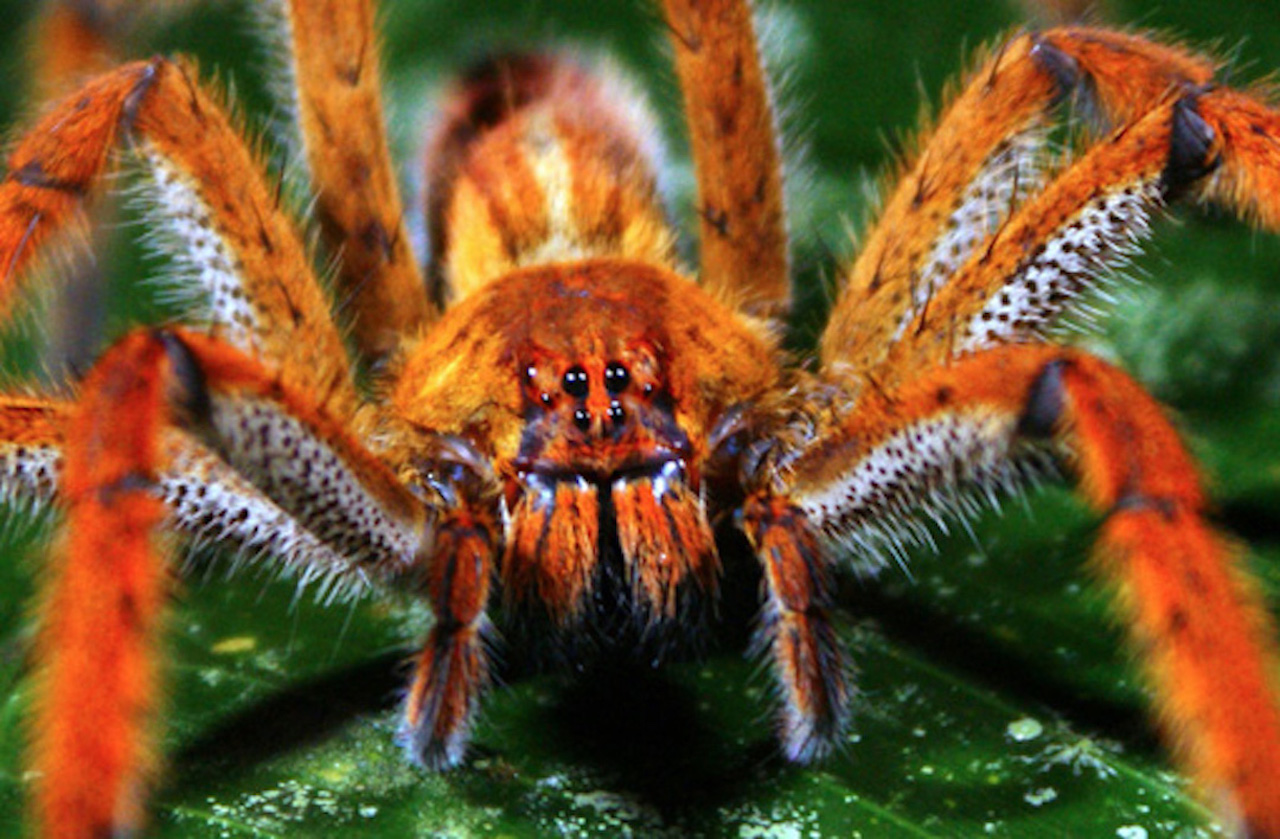
Aereth Tramp Spider
A particularly unpleasant arachnid is the tramp spider (wandering spider, the wanderer). It is known worldwide although its appearance will vary slightly in color. He is big, comes in many shades of brown to nearly black, hairy and aggressive as he only wanders when he's searching for a mate. This spider's fangs can pierce through a fingernail or toenail and the neurotoxin it delivers in a bite can be lethal. Although a tropical species, it is being found among imported fruits and vegetables from the southern islands and continents. As spiders are highly adaptive, a few are being found making themselves at home in the northern climes.
The spiders can grow to have a leg span of 5.1 to 5.9 inches. Their body length ranges from 0.67 to 1.89 inches. The species is distinguished from other related genera by the presence of dense prolateral scopulae (a dense brush of fine hairs) on the pedipalp tibiae and tarsi in both sexes. The presence of a dark linear stripe or stripes on the frontal (dorsal) palps and presence of a single thin black line running anterior-posterior along the dorsal carapace may help identify the wanderer. Other features are the strong ventral marking on the underside of the legs with contrasting dark mid-segments and lighter joints, and the pattern on the ventral (underside) of the abdomen with several rows of black dots, or an overall reddish colour.
The characteristic defensive posture with frontal legs held high is an especially good indicator to confirm a specimen is a tramp spider, especially alongside correct colour patterns. During the defensive display, the body is lifted up into an erect position, the first two pairs of legs are lifted high (revealing the conspicuous black/light-banded pattern on the leg underside), while the spider sways from side to side with hind legs in a cocked position.
Tarantulas
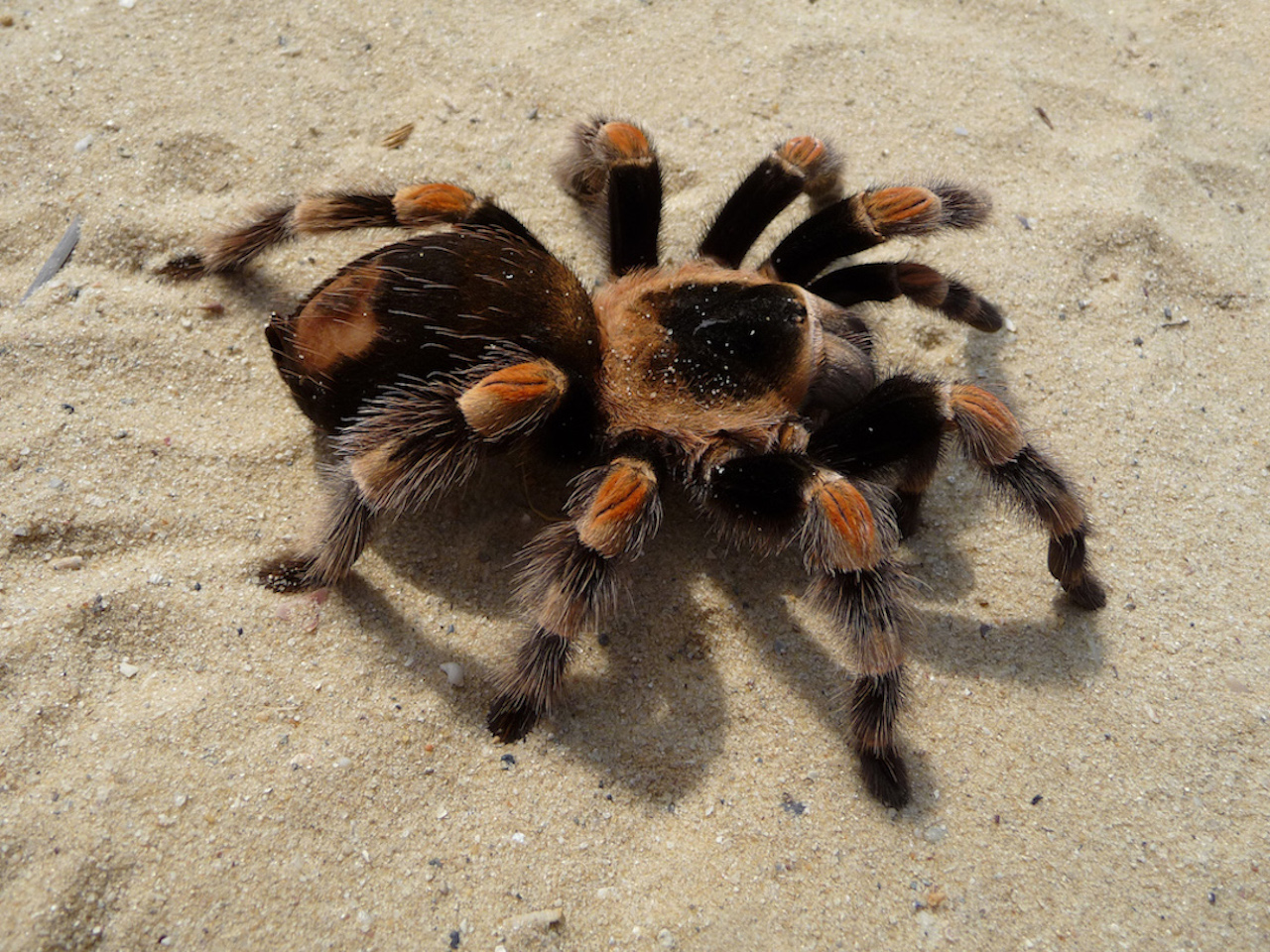
Common Tarantula
Like all arthropods, the tarantula is an invertebrate that relies on an exoskeleton for muscular support. Like other Arachnids, a tarantula’s body comprises two main parts, the prosoma (or cephalothorax) and the opisthosoma (or abdomen). The prosoma and opisthosoma are connected by the pedicle or pregenital somite. This waist-like connecting piece is actually part of the prosoma and allows the opisthosoma to move in a wide range of motion relative to the prosoma.
Tarantula sizes range from as small as a fingernail to as large as a dinner plate when the legs are fully extended. Depending on the species, the body length of tarantulas ranges from 1 to 4 in, with leg spans of 3–12 inches. Leg span is determined by measuring from the tip of the back leg to the tip of the front leg on the opposite side. Some of the largest tarantulas may weigh over 3 ounces; the largest of all, the birdeater has been reported to attain a weight of 5.3 ounces, and a leg-span of up to 12 inches, males being the longer and females greater in girth.
Sidan Silkweaver*
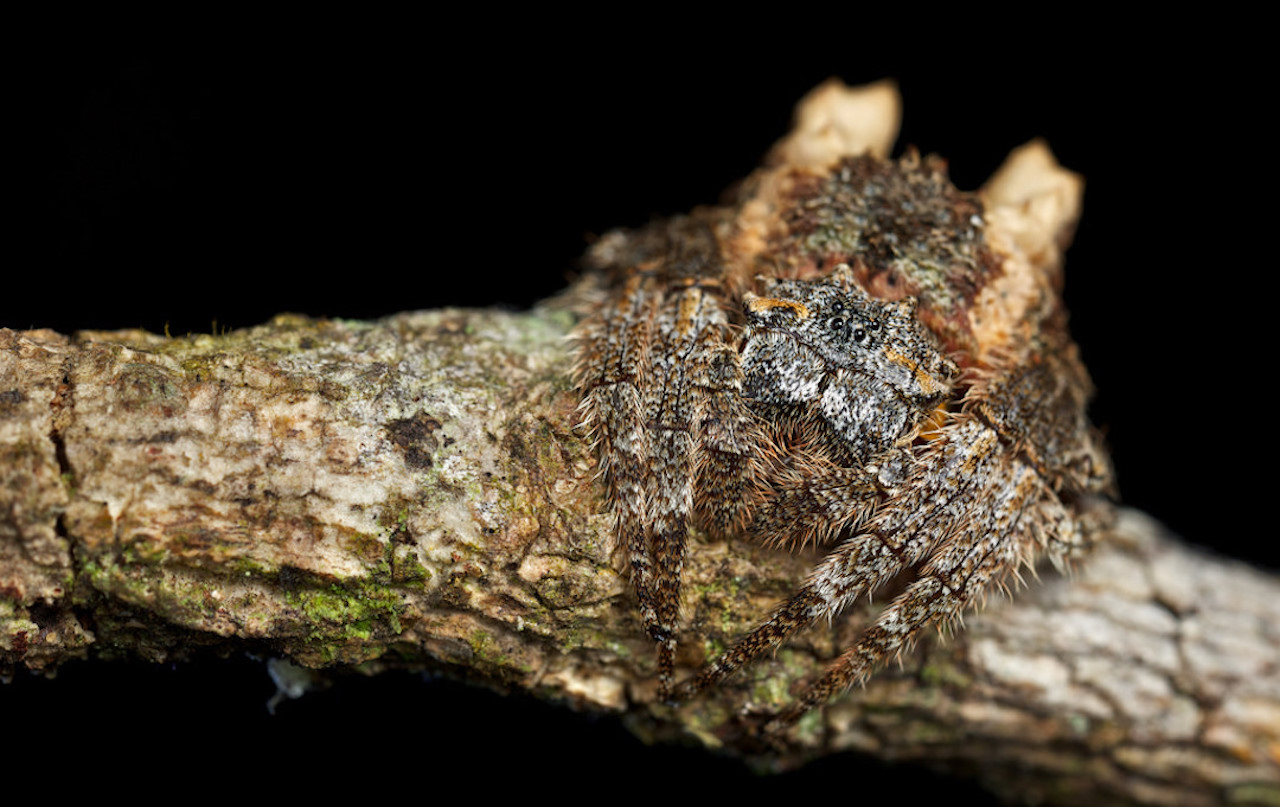
Female Silk Weaver
Sidan Silkweaver spiders are a species of extremely large orb-weaver spider that produces the largest known orb webs, ranging from 140 to 4,340 square inches with anchor lines spanning up to 85 feet. Subspecies of these spiders are found in forests all over Aereth except the polar ice caps. The largest and most prized variety is native to the Elderwood region of Tír Ceilte.
Like other orb-weaver spiders, they exhibit extreme sexual dimorphism with large females and small males. Females can reach up to a 12-inch leg-span and 1.8 inches in total body length. Males are approximately one third or less the size of the females. Females are largely black in color, with white hairs on the cephalothorax (opisthosoma), abdomen and appendages. Males are redder and lighter brown in color, again with white hairs on the cephalothorax, abdomen, and parts of the appendages further from the body. The top of the male's abdomen is marked with a brilliant blue, red, and gold pattern. They are often called Peacock Spiders and mistaken by foreigners as a separate species.
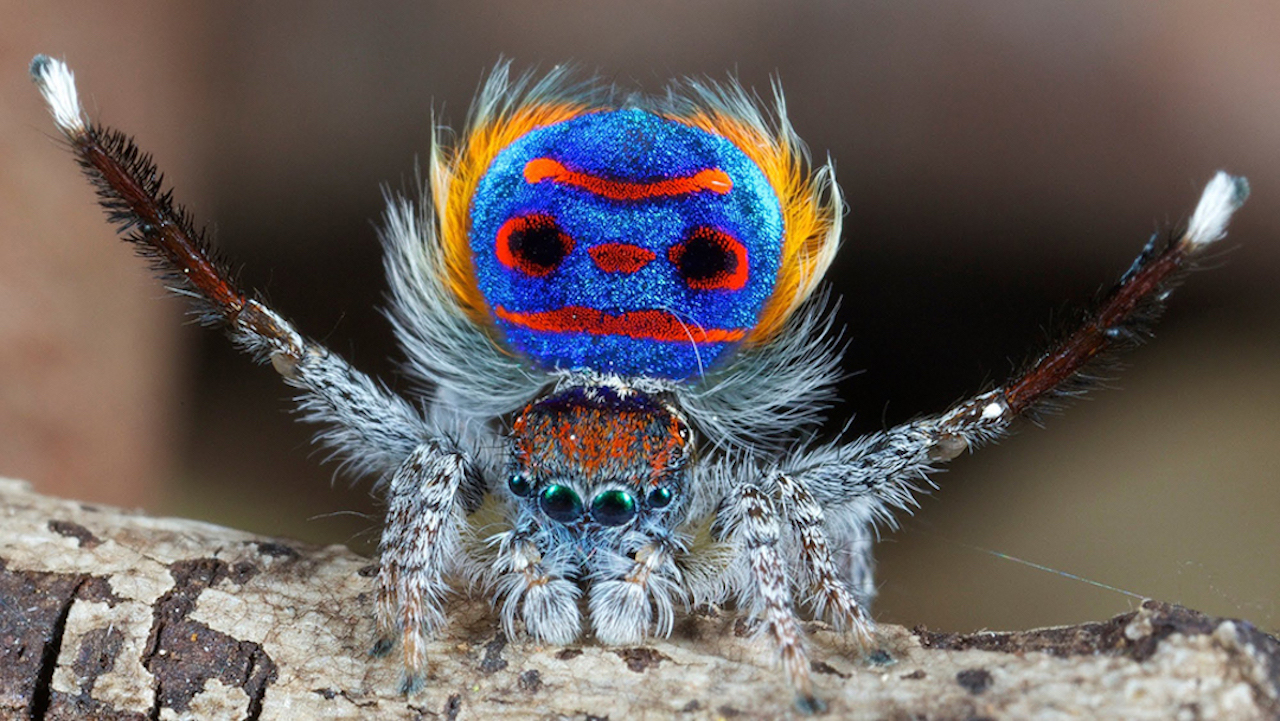 Male Sidan Silk Weaver
Male Sidan Silk Weaver
Unlike most arachnids, these large spiders adapt well to captivity and even come to associate the Sídhe that farm them with being fed. They are far less aggressive than most spiders although females with eggs can get territorial over their webs. Sidan Silkweavers are venomous but, like most tarantulas, their bite, although painful due to the size of their fangs, is harmless to humans. Also, like tarantulas, the Sidan is hairy and can use their hind legs to launch hairs at an aggressor. The individual hairs are spiky and can cause stinging, burning, and itching when they embed in the skin or eyes. A solution of vinegar and water will aid in removing the hairs from bare skin, but eyes should be rinsed with flowing clear water only.
The Sidan Silkweavers do not exist outside of the Elderwood on Tír Ceilte. Attempts to remove breeding pairs of spiders has never worked. They simply will not survive in other environments. For this reason, the Sídhe that farm the spiders for their silk live within the Elderwood. Once harvested, the silk is then sold or traded to the Sidan Weavers Guild.
Note: The spiders are not harmed during silk harvesting. After they have hatched their eggs, the web is abandoned for the winter while the spiders move into lairs deep inside the great chee-chimer trees of the Elderwood to hibernate.
Uses for Sidan Silk
Sidan silk has a huge variety of uses from clothing to being woven into the strands of hemp or sinew used to make bowstrings. The most notable use is for garments worn beneath armor to help protect the wearer. Depending on the weapon used, Sidan Silk is known to entangle arrow and spear points, deflecting them from causing serious injury.
The Sidhe have a monopoly on Sidan Silk and the silkweaver spiders.
*Note: The size of the Sidan Silk Weaver is based on the dimensions of the Giant Huntsman spider. The other information is based on the recently discovered (2009) Darwin’s Bark Spider. Reference: Wikipedia.